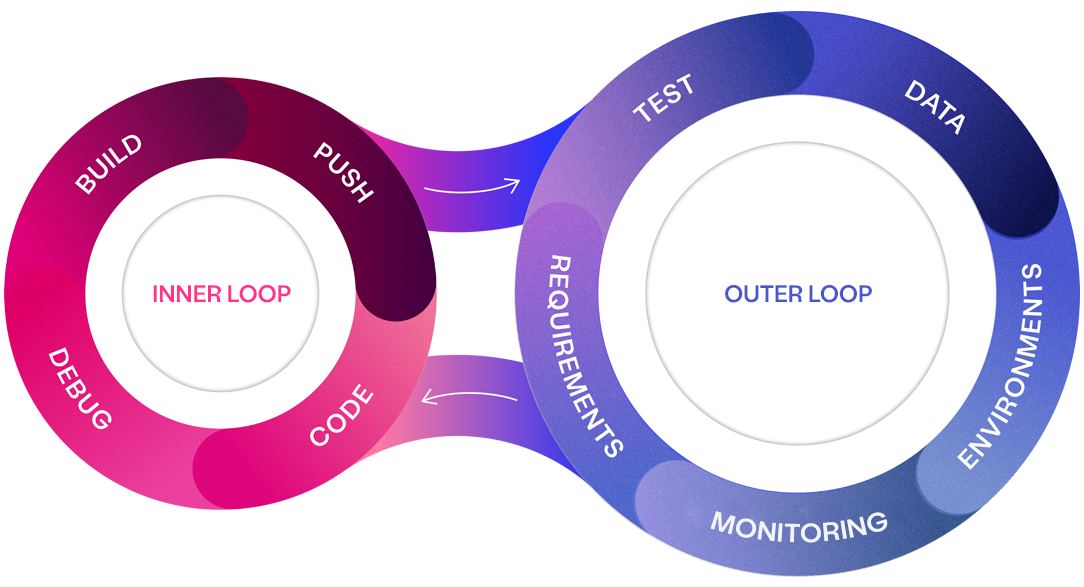Developing, testing, and releasing software may not seem at the surface like a monumental task. However, in today’s world where virtually every organisation is reliant on software, speed, and quality of delivery can have a direct impact on a company’s key business outcomes. It affects everything from time-to-market to cost reduction, to the overall quality of the software delivered.
Software delivery productivity is a measure of how efficiently software can be delivered. Unfortunately, many organisations struggle with low productivity, facing delays, cost overruns, and subpar software quality despite their best efforts.
The question is, why are so many organisations struggling with software delivery productivity? Despite advancements in tools and techniques, enterprises continue to face significant barriers.
What is software delivery productivity?
Software delivery productivity refers to how efficiently an organisation can define, develop, test, and release software. It’s more than just about speeding up development; it’s about ensuring that each phase of software delivery, from the initial requirements gathering to final deployment, is executed with both efficiency and quality in mind.
Software delivery productivity must balance two key components -
Inner loop productivity – Improving developer efficiency is critical, as it directly impacts the pace of code delivery. However, faster development alone does not guarantee overall success.
Outer loop quality – The outer loop plays a crucial role in ensuring that key assets—such as requirements, test data, and environments—are high quality. Poor requirements lead to misinterpretations, causing developers to either build the wrong thing or spend time in clarification meetings, interrupting developer flow. A lack of adequate test data or environments means teams often must wait, unable to test or develop certain scenarios effectively. In addition, low-quality output from the outer loop results in rework and firefighting defects, which slow down the entire process and undermine any speed gained in development.

Variations in software delivery flow can cause productivity spikes and drops, highlighting the need for consistent alignment between the inner and outer loops.
To achieve true software delivery productivity, organisations must balance speed and quality. Rushing development at the expense of the outer loop leads to poor outcomes that require rework, delay releases, and increase costs. Many organisations struggle with this balance, focusing too heavily on inner loop productivity while neglecting the crucial outer loop processes. The result is bottlenecks, compromised software quality, and missed deadlines.
Why are so many organisations struggling?
Many organisations are actively investing in improving their software delivery processes, with roles like product owners, testers, and business analysts playing essential parts in the overall workflow. However, the pressure to deliver software faster and in greater volume continues to mount. Developers, with the help of advanced tools, are capable of moving at incredible speed, but this rapid pace creates challenges in balancing both speed and quality.
As organisations push for quicker delivery, the outer loop activities—such as gathering clear requirements, conducting thorough testing, and managing data—often get deprioritised or cut altogether. This results in poor requirements, where teams constantly scramble for clarification, leading to misalignment and rework. Additionally, not allowing enough time for testing results in poor-quality software, where defects go unnoticed until much later in the process.
 The Inner Loop is reliant on quality assets from the Outer Loop to operate efficiently.
The Inner Loop is reliant on quality assets from the Outer Loop to operate efficiently.
Ultimately, this creates a self-sabotaging loop. The more organisations try to accelerate delivery by cutting corners in the outer loop, the more they end up causing delays and lowering the overall quality of their software. Instead of improving productivity, they are inadvertently setting themselves up for failure by creating bottlenecks and introducing defects that require extensive rework.
How to improve software delivery productivity: A path to alignment
To unlock true software delivery productivity, organisations must focus on rebalancing the inner and outer loops. For sustained productivity, businesses need to optimise both loops to work in harmony.
Rebalancing inner and outer loops - The key to improving productivity lies in addressing not just how quickly developers can code, but also how effectively the outer loop supports them. This means focusing on requirements engineering, continuous testing, and high-quality test data provisioning. By implementing living documentation—which is constantly updated throughout the project—and continuous feedback loops, organisations can ensure that their requirements are clear, accurate, and understood by all teams. High-quality test data and environments should also be provisioned proactively to eliminate delays and allow testing to begin as early as possible in the development cycle.
 Improving collaboration across teams - A common barrier to productivity is the presence of silos between development, testing, and business teams. To break down these silos, organisations must promote cross-functional collaboration. This involves encouraging open communication between teams, ensuring that all stakeholders—developers, testers, and analysts—are working toward shared goals. By fostering collaboration, teams can reduce rework, clarify roles, and streamline the software delivery process.
Improving collaboration across teams - A common barrier to productivity is the presence of silos between development, testing, and business teams. To break down these silos, organisations must promote cross-functional collaboration. This involves encouraging open communication between teams, ensuring that all stakeholders—developers, testers, and analysts—are working toward shared goals. By fostering collaboration, teams can reduce rework, clarify roles, and streamline the software delivery process.
Continuous testing and shift-left strategies - To improve both speed and quality, organisations should embrace continuous testing and shift-left strategies. This means testing earlier in the development cycle and integrating automated testing processes to identify issues as early as possible. By doing this, teams can catch bugs before they become more costly and disruptive, ultimately reducing the need for rework and speeding up the overall delivery process.
Living documentation for better requirements - Living documentation plays a critical role in maintaining clear and up-to-date requirements. Unlike static documentation, which can become outdated or inaccurate, living documentation evolves alongside the project. This approach reduces confusion and miscommunication, ensures that all teams have a shared understanding of project requirements, and minimises the need for clarifications and rework as the project progresses.
Test data strategy - A robust test data strategy is essential for avoiding delays and ensuring comprehensive test coverage. Organisations should prioritise the provision of on-demand, accurate test data that mirrors real-world scenarios. This reduces the time developers and testers spend creating or searching for data, allowing them to focus on building and validating the software. By implementing automated test data management processes, teams can ensure they have the data they need when they need it.
Technical debt management - Managing technical debt is crucial for maintaining long-term productivity. Accumulated technical debt from legacy systems or quick fixes can slow down development and increase maintenance costs. By regularly addressing and mitigating technical debt, organisations can reduce the time spent on maintenance and allow teams to focus more on innovation and delivering new features, rather than constantly patching old code.
Benefits of enhancing software delivery productivity
Improving software delivery productivity offers a range of benefits that positively impact both the productivity and quality of software development.
Faster time to market - When both inner and outer loop processes are aligned, organisations can achieve quicker, high-quality releases. Developers are no longer held back by unclear requirements or insufficient test data, allowing them to move seamlessly from coding to testing and deployment. This alignment removes bottlenecks, ensuring that software is delivered faster, without sacrificing quality, and helping companies stay ahead of competitors.
Improved quality and reliability - Enhancing productivity through continuous and early testing, clear requirements, and adequate test data leads to higher-quality software with fewer bugs and issues. By catching defects early and thoroughly testing with realistic data, teams can release more reliable software. This reduces the need for post-launch fixes and increases customer satisfaction, as the software is more robust and performs as expected in production environments.

Focusing on software quality earlier leads to a higher-quality deliverable.
Better collaboration and reduced rework - Breaking down silos and fostering cross-functional collaboration allows teams to work more cohesively, reducing miscommunication and unnecessary rework. When teams—developers, testers, and business analysts—are aligned, they can prevent issues before they escalate, significantly cutting down delays and errors. This leads to a more efficient workflow and helps the entire organisation move toward its goals faster.
Retaining top talent - A more productive and collaborative work environment, where teams experience fewer firefighting incidents and less rework, contributes to higher job satisfaction. Developers are able to focus on creative, high-value work rather than constantly managing defects or unclear requirements. This positive work environment helps retain skilled team members, reducing turnover and ensuring that valuable expertise stays within the organisation. Keeping top talent is essential for maintaining long-term productivity and innovation.
The outer loop is key for delivery productivity
In today's software-driven world, achieving high levels of software delivery productivity is essential for business success. The speed and quality of software delivery directly impact crucial outcomes such as time-to-market, cost efficiency, and customer satisfaction. However, many organisations continue to struggle with low productivity, despite significant investments in tools and resources.
The core challenge lies in balancing speed with quality. While advancements in the inner loop—tools that enhance coding efficiency—have undoubtedly improved developer productivity, focusing solely on this aspect of the software delivery lifecycle often leads to bottlenecks and poor-quality outcomes. As we’ve seen, neglecting the outer loop—activities like gathering clear requirements, ensuring test data availability, and managing environments—creates systemic problems that undermine productivity and delay releases.
To truly improve productivity, organisations must optimise both the inner and outer loops. Curiosity’s Enterprise Test Data Platform addresses this need by providing critical capabilities for outer loop productivity. This ensures that teams have access to high-quality assets, enabling smoother workflows, faster time-to-market, and improved software quality.
Software delivery productivity is about more than just coding faster—it’s about delivering the right software, at the right time, with the right level of quality. By aligning the inner and outer loops and investing in both speed and quality, organisations can overcome the barriers to productivity and set themselves up for long-term success in an increasingly competitive landscape.
Turbocharge software delivery
Our outer loop experts will help you identify symptoms of inner/outer loop misalignment at your enterprise, crafting a roadmap to software delivery productivity and quality.










